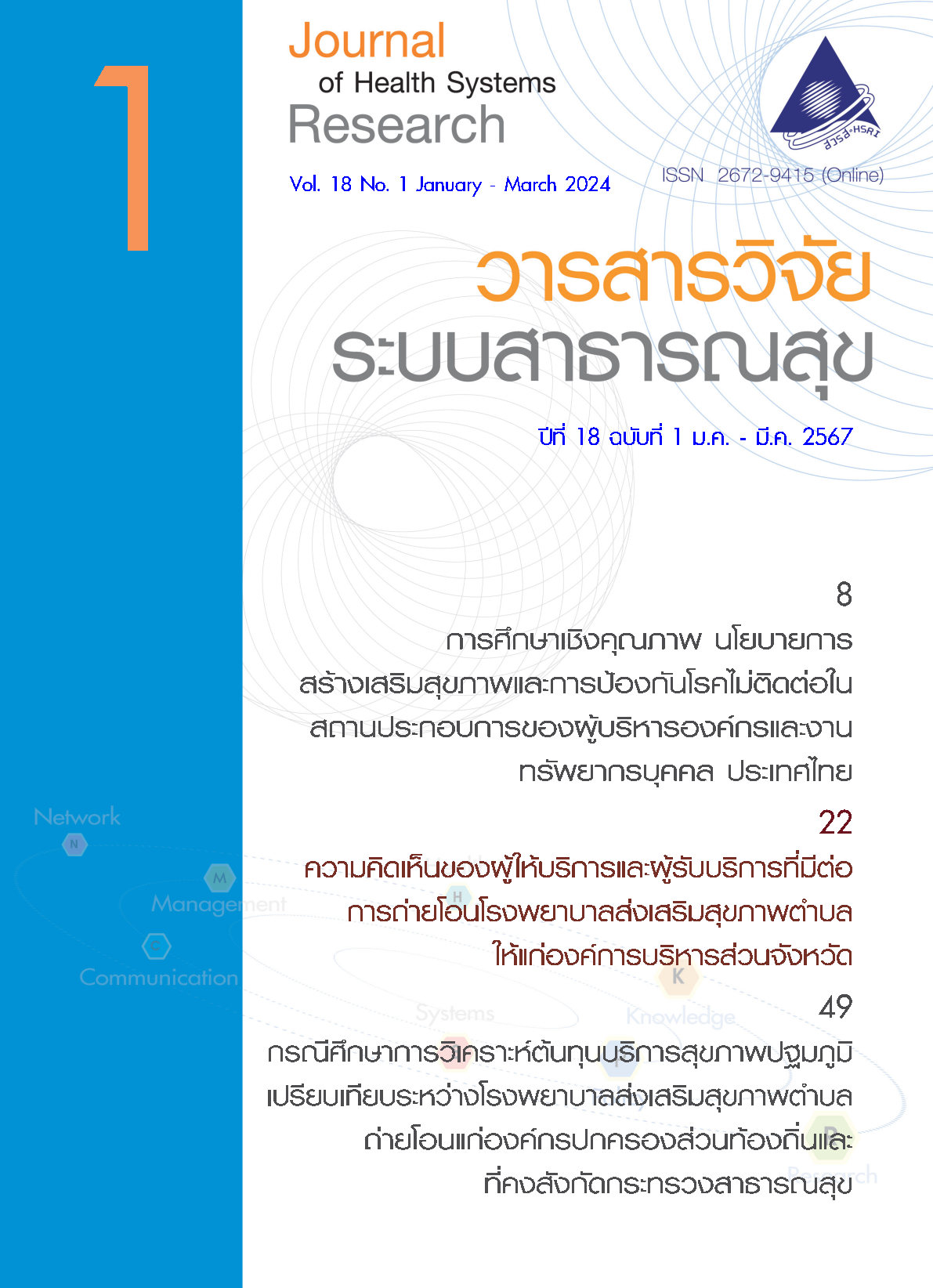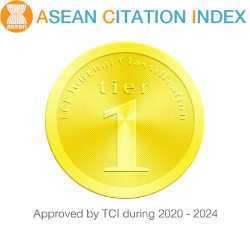ปัจจัยที่ทำให้อาสาสมัครสาธารณสุขประจำหมู่บ้านยอมรับนวัตกรรมการคัดกรองผู้สูงอายุในชุมชนทางระบบเว็บ
คำสำคัญ:
การคัดกรองผู้สูงอายุ 9 ด้าน, การยอมรับเทคโนโลยี, อาสาสมัครสาธารณสุข (อสม.), ระบบทางเว็บบทคัดย่อ
การศึกษานี้เป็นการศึกษาวิจัยแบบผสมผสาน (mixed methods research) สืบเนื่องจากมีการนำแนวคิดการจัดบริการสำหรับผู้สูงอายุแบบบูรณาการขององค์การอนามัยโลก (World Health Organization: Integrated Care for Older People, WHO: ICOPE) มาใช้ ซึ่งเป็นแนวคิดที่มุ่งเน้นการค้นหาภาวะถดถอยโดยใช้เครื่องมือคัดกรองผู้สูงอายุ 9 ด้านเพื่อสร้างเสริมสุขภาพป้องกันการเกิดภาวะพึ่งพิงของผู้สูงอายุ เริ่มตั้งแต่ระดับชุมชนที่มีอาสาสมัครสาธารณสุขเป็นผู้ร่วมดำเนินการ จึงทำการศึกษาหาปัจจัยที่ส่งผลต่อการยอมรับของอาสาสมัครสาธารณสุข (อสม.) ในการนำนวัตกรรมการคัดกรองผู้สูงอายุ 9 ด้านในชุมชนทางระบบเว็บมาใช้ การศึกษานี้ทำใน อสม. ของเขตเทศบาลเมืองเพชรบูรณ์ จำนวน 116 คน ทำการศึกษาเชิงปริมาณโดยรวบรวมข้อมูลจากแบบสอบถามเกี่ยวกับปัจจัยที่คาดว่าจะมีความสัมพันธ์ต่อการนำเทคโนโลยีมาใช้ในการทำงานของ อสม. จากนั้นจึงได้ทำการศึกษาเชิงคุณภาพด้วยการสนทนากลุ่มกับ อสม. และพี่เลี้ยง รวมจำนวน 15 คน ใช้สถิติเชิงพรรณนาในการวิเคราะห์ข้อมูลทั่วไปและสถิติเชิงอนุมานโดยใช้สถิติ multiple linear regression เพื่อหาปัจจัยที่ส่งผลต่อการนำเทคโนโลยีมาใช้ในการทำงานของ อสม. และทำการวิเคราะห์ข้อมูลเชิงคุณภาพ
ผลการศึกษาพบว่า ปัจจัยด้านความคาดหวังต่อประสิทธิภาพ ด้านการสนับสนุนจากผู้บังคับบัญชา มีผลโดยตรงต่อการยอมรับการใช้นวัตกรรมเทคโนโลยีของ อสม. อย่างมีนัยสำคัญทางสถิติ (p-value < 0.05) และปัจจัยประสบการณ์และพฤติกรรมการใช้เทคโนโลยี เป็นปัจจัยที่ส่งผลต่อการยอมรับการใช้นวัตกรรมเทคโนโลยีมาใช้ในการทำงานของ อสม. อย่างมีนัยสำคัญทางสถิติ (p-value < 0.05) นอกจากนี้ยังรวมถึง สังคมรอบข้างมีอิทธิพลต่อการตัดสินใจทดลองใช้ คุณภาพของข้อมูลและระบบงาน การมีทีมพี่เลี้ยงสำหรับสอนงานโดยเจ้าหน้าที่ก็เป็นอิทธิพลเชิงบวกต่อความตั้งใจที่จะเรียนรู้การใช้งานนวัตกรรมเช่นกัน
เอกสารอ้างอิง
Foundation of Thai Gerontology Research and Development Institute. Situation of the Thai elderly 2021. Nakhon Pathom: Institute for Population and Social Research, Mahidol University; 2022. (in Thai)
Office of the National Economic and Social Development Council. Report of the Population Projections for Thailand 2010-2040 (Revised Edition). Bangkok: Office of the National Economic and Social Development Council; 2019. (in Thai)
World Health Organization. Integrated care for older people: guidelines on community-level interventions to manage declines in intrinsic capacity. Geneva: World Health Organization; 2017.
World Health Organization. Integrated care for older people (ICOPE): guidance for person-centred assessment and pathways in primary care. Geneva: World Health Organization; 2019.
Department of Health Service Support. Handbook for prototype: guideline for redesign aging service delivery. 1st ed. Nonthaburi: Ministry of Public Health; 2020. p 16-7. (in Thai)
Bragg M. Crisis and change: the important of employee engagement during period of change. Engage for Success [internet]; 2021 [cited 2021]. Available from: https://engageforsuccess.org/crisis-and-change/boosting-employee engagement-through-effective-communication/.
Pluenam P. Concepts and evolution of technology acceptance model. Modern Management Journal 2013;9(1):9–17. (in Thai)
Wikipedia. Technology acceptance model [internet]. 2020 [cited 2020 Nov]. Available from: https://en.wikipedia.org/wiki/Technology_acceptance_model.
Adi A, Mostafa A, Khaled S. Technology acceptance in healthcare: a systematic review. Journal of Applied Sciences 2021;11(22):10537.
Phaongthong N. Factors Influencing falls prevention behavior among the elderly in Thap Than district, Uthai Thani province (master’s thesis). Phitsanulok: Naresuan University; 2021. (in Thai)
Prathum S, U-senyang S. Information technology acceptance in the new normal. Journal of Lawasri. Lopburi: Thepsatri Rajabhat University; 2022;6(1):1-18. (in Thai)
Sangkularb MP. Technology acceptance in healthcare: a case study of health service search (master’s thesis). Bangkok: Thammasat University; 2018. (in Thai)
Nawamawat J, Sittisart V, Lekphet K, Thianthawon P. The village health volunteers and community involvement on prevention and surveillance the COVID-19 infection in the community by using the geographic information system. Nakhon Sawan: Boromarajonani College of Nursing Sawanpracharak Nakhonsawan; 2021. (in Thai)
Nilsen RE, Dugstad J, Eide H, Gullslett KM, Eide T. Exploring resistance to implementation of welfare technology in municipal healthcare services – a longitudinal case study. BMC Health Services Research [internet]. 2016 Nov [cited 2016 Nov 15];16(1):657. Available from: https://pubmed.ncbi.nlm.nih.gov/27846834/. doi: 10.1186/s12913-016-1913-5.
Fredriksen E, Thygesen E, Moe CE, Martinez S. Digitalisation of municipal healthcare collaboration with volunteers: a case study applying normalization process theory. BMC Health Service Research [internet]. 2021 May [cited 2021 May 01];21:410. Available from: https://bmchealthservres. biomedcentral.com/articles/10.1186/s12913-021-06429-w. doi: https://doi.org/10.1186/s12913-021-06429-w.
ดาวน์โหลด
เผยแพร่แล้ว
รูปแบบการอ้างอิง
ฉบับ
ประเภทบทความ
สัญญาอนุญาต
ลิขสิทธิ์ (c) 2024 วารสารวิจัยระบบสาธารณสุข

อนุญาตภายใต้เงื่อนไข Creative Commons Attribution-NonCommercial-NoDerivatives 4.0 International License.
วารสารวิจัยระบบสาธารณสุขอยู่ภายใต้การอนุญาต Creative Commons Attribution-NonCommercial-NoDerivatives 4.0 International (CC BY-NC-ND 4.0) เว้นแต่จะระบุไว้เป็นอย่างอื่น




